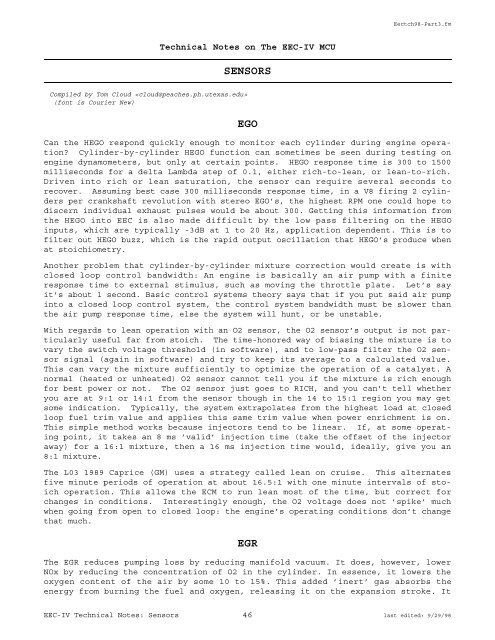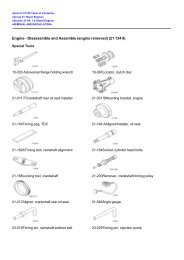TECHNICAL NOTES ON THE EEC-IV MCU - Auto diagnostics
TECHNICAL NOTES ON THE EEC-IV MCU - Auto diagnostics
TECHNICAL NOTES ON THE EEC-IV MCU - Auto diagnostics
You also want an ePaper? Increase the reach of your titles
YUMPU automatically turns print PDFs into web optimized ePapers that Google loves.
Technical Notes on The <strong>EEC</strong>-<strong>IV</strong> <strong>MCU</strong><br />
SENSORS<br />
Compiled by Tom Cloud <br />
(font is Courier New)<br />
EGO<br />
Eectch98-Part3.fm<br />
Can the HEGO respond quickly enough to monitor each cylinder during engine operation?<br />
Cylinder-by-cylinder HEGO function can sometimes be seen during testing on<br />
engine dynamometers, but only at certain points. HEGO response time is 300 to 1500<br />
milliseconds for a delta Lambda step of 0.1, either rich-to-lean, or lean-to-rich.<br />
Driven into rich or lean saturation, the sensor can require several seconds to<br />
recover. Assuming best case 300 milliseconds response time, in a V8 firing 2 cylinders<br />
per crankshaft revolution with stereo EGO’s, the highest RPM one could hope to<br />
discern individual exhaust pulses would be about 300. Getting this information from<br />
the HEGO into <strong>EEC</strong> is also made difficult by the low pass filtering on the HEGO<br />
inputs, which are typically -3dB at 1 to 20 Hz, application dependent. This is to<br />
filter out HEGO buzz, which is the rapid output oscillation that HEGO’s produce when<br />
at stoichiometry.<br />
Another problem that cylinder-by-cylinder mixture correction would create is with<br />
closed loop control bandwidth: An engine is basically an air pump with a finite<br />
response time to external stimulus, such as moving the throttle plate. Let’s say<br />
it’s about 1 second. Basic control systems theory says that if you put said air pump<br />
into a closed loop control system, the control system bandwidth must be slower than<br />
the air pump response time, else the system will hunt, or be unstable.<br />
With regards to lean operation with an O2 sensor, the O2 sensor’s output is not particularly<br />
useful far from stoich. The time-honored way of biasing the mixture is to<br />
vary the switch voltage threshold (in software), and to low-pass filter the O2 sensor<br />
signal (again in software) and try to keep its average to a calculated value.<br />
This can vary the mixture sufficiently to optimize the operation of a catalyst. A<br />
normal (heated or unheated) O2 sensor cannot tell you if the mixture is rich enough<br />
for best power or not. The O2 sensor just goes to RICH, and you can’t tell whether<br />
you are at 9:1 or 14:1 from the sensor though in the 14 to 15:1 region you may get<br />
some indication. Typically, the system extrapolates from the highest load at closed<br />
loop fuel trim value and applies this same trim value when power enrichment is on.<br />
This simple method works because injectors tend to be linear. If, at some operating<br />
point, it takes an 8 ms ’valid’ injection time (take the offset of the injector<br />
away) for a 16:1 mixture, then a 16 ms injection time would, ideally, give you an<br />
8:1 mixture.<br />
The L03 1989 Caprice (GM) uses a strategy called lean on cruise. This alternates<br />
five minute periods of operation at about 16.5:1 with one minute intervals of stoich<br />
operation. This allows the ECM to run lean most of the time, but correct for<br />
changes in conditions. Interestingly enough, the O2 voltage does not ’spike’ much<br />
when going from open to closed loop: the engine’s operating conditions don’t change<br />
that much.<br />
EGR<br />
The EGR reduces pumping loss by reducing manifold vacuum. It does, however, lower<br />
NOx by reducing the concentration of O2 in the cylinder. In essence, it lowers the<br />
oxygen content of the air by some 10 to 15%. This added ’inert’ gas absorbs the<br />
energy from burning the fuel and oxygen, releasing it on the expansion stroke. It<br />
<strong>EEC</strong>-<strong>IV</strong> Technical Notes: Sensors 46 last edited: 9/29/98




